
A rapid rise in carbon dioxide has raised the prospect of human extinction in decades, but that catastrophic event can still be prevented relatively easy. That was the sobering, but ultimately optimistic...

A rapid rise in carbon dioxide has raised the prospect of human extinction in decades, but that catastrophic event can still be prevented relatively easy. That was the sobering, but ultimately optimistic...
Richard Broadbent, an environmental lawyer at Freeths, writes that landowners require certainty, clarity and careful forward planning if we are to reverse the chronic biodiversity decline we have seen over the past 100 years
Aardman Animations' Peter Lord, most notable for developing Wallace and Gromit, is behind the project
Over past two years, 70 farmers have been told to install water metres owing to excess usage